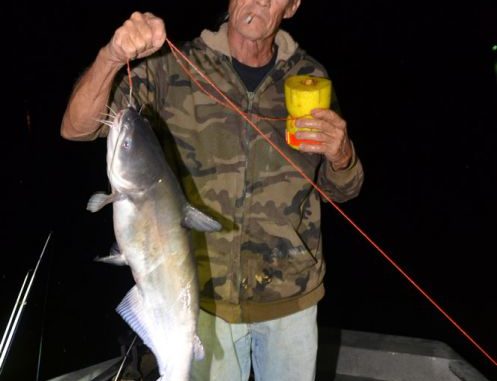
Nighttime is the right time for catfish — and this jugline specialist shares his tips from False River.
It was black on the water. Of course, it was midnight.
We sat as quiet as death in Sidney Haynes’ 17-foot aluminum SeaArk boat. In the distance, automobile headlights flitted busily through New Roads, perched hard on the shores of False River, the big oxbow lake of Pointe Coupee Parish.
Where were all the people going? What were they thinking? Could they know we were peeping at them from the lake’s darkness?
Haynes’ lighter sparked.
As he took a hard drag on his cigarette, I could see the outlines of his craggy outdoorsman’s face. His younger partner and brother-in-law, 43-year-old Christopher Guillaume, followed his lead and lit one of his own.
After a few minutes of silence, Haynes softly spoke, “I guess it’s getting time to go check the juglines.”
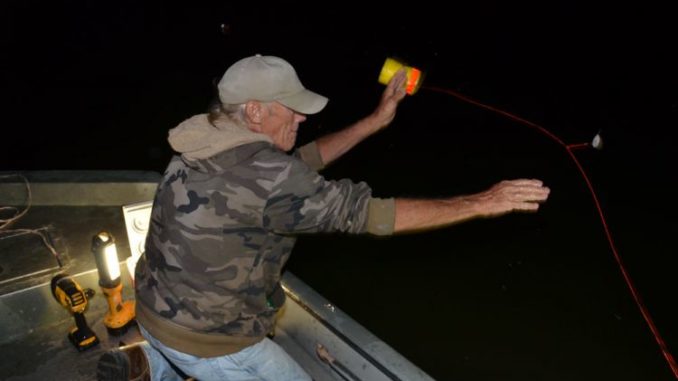
We were hunting catfish, Haynes’ specialty — and nighttime is the right time for catfish.
We met several hours before dark at the boat launch in Ventress. The pair wanted to work the canals in that end of the lake to catch more bream for cut bait. Both were using spincast reels to flip small earthworm-baited hooks under corks to the shallows near the canal’s banks.
Guillaume was a fishing machine, flipping bream after bream in the boat. “He’s really catching ‘em,” observed Haynes lackadaisically. “That’s OK. My time is coming after dark when I put my jugs out.”
The plan was to set the jug lines out right at dusk. After they went out, they would anchor near the jugs and fish rods and reels tight-lined on the bottom for more catfish while the jugs worked.
Bait for the juglines would be cut shad cast-netted from City Park Lake in Baton Rouge and hook-caught bream, what they called “perch.” Haynes cautioned, “You can’t legally use a cast net for perch. You have to catch them on hooks.” Like the shad, the perch were cut into bait-sized pieces and stored on ice.
Bait for the rods and reels would be bait shop-purchased Canadian nightcrawlers, commonly called “cold worms.”
As the sun neared setting, Haynes began to tense. He was ready.
The set-up
Guillaume idled the boat out of the canal and into the lake, where watching the depth sounder, he moved back and forth across the lake planning the layout in 5 to 7 feet of water. The two ends of the ribbon-shaped lake have an expanse of relatively shallow water, locally called “the flats,” and the preferred place to set their juglines.
He bumped the boat in and out of gear while Haynes unwrapped and baited each line with the pre-cut bait. They placed them 50 to 60 feet apart in an arching line. “You want enough space between them to be able to run the boat around each one without tangling up,” he explained.
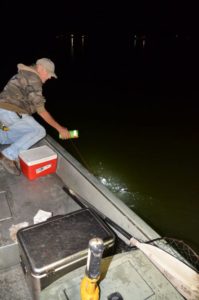
By 8 p.m., all 39 lines were all out. Guillaume idled to near the middle of the line of floats, where Haynes dropped the anchor and picked up a big DeWalt spotlight. “I can just turn the light on the jugs and they will light up like Christmas lights.”
Haynes settled into a seat and took a smoke break. The younger man didn’t take a break. He quickly baited three rods and reels with cold worms and chunked them out, propping each one up within a hand’s reach.
Haynes laughed. “He normally fishes with three. When all three get to bouncing, he’ll go psycho.”
Haynes finally baited one rod, also with worms. “In about an hour, we’ll go down the line and check them. Sometimes they won’t move the jug until the boat gets close.”
The catching
At 8:16 p.m., Guillaume drew first blood with a 1 ½ pound channel cat. From then on, he kept busy setting hooks, reeling in fish, rebaiting and casting.
“We’ve lost many a rod like this,” said Haynes, referring to the multiple baited rods out at one time. “A big fish just takes it and it’s gone — never see it again.”
“I lost my favorite bass rod like that,” mourned Guillaume. “That’s why I fish these cheap spinning rods. And I always use white rods so that I can see any movement of the rod in the dark.”
A little after 9 p.m., Guillaume verbally nudged Haynes. “Let’s go check ‘em.” They swapped places, with the younger man moving from the bow, where he fished, to the controls and Haynes taking his place on the bow holding the spotlight.
As they slowly passed each jug, Haynes picked it up just far enough to check for bait. About a third of them were missing bait and needed rebaiting. Hooked fish were dropped into an ice chest.
Guillaume chugged past the end of the line, anchored in 7 feet of water and immediately got his lines back into the water. “It’s still early,” he mumbled. “It’s only 10 p.m.”
They repeated the routine every hour or so. Between runs Guillaume tended his rods closely, constantly turning the reel handles to keep the lines tight enough to see the least nibble.
Tales of the dark
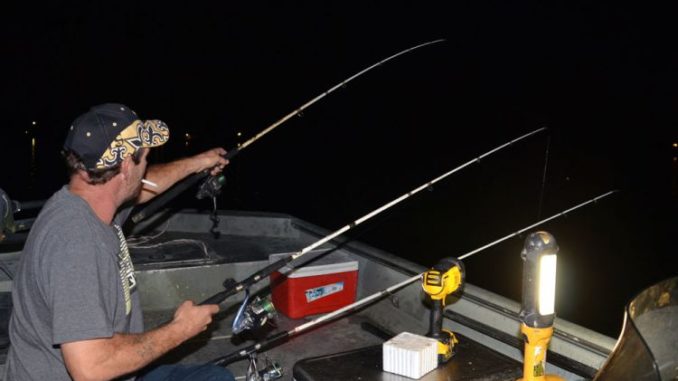
The fishing pace the pair kept left lots of time for talking and Haynes didn’t disappoint, regaling Guillaume with tales of his many years on the water and in the woods.
He opened with bigfoot. He called them “skunk apes,” and claimed to have had two encounters with the creatures. “One in Sherburne (now a wildlife management area) tore up the woods all around us in the dark.
“The other one was in Greensburg. I got four witnesses to that one — and they are alive to this very day.
“I even went bigfoot hunting in Arkansas.”
Sherburne, where he killed a 270-pound, 11-point deer the previous year, is one of his favorite spots in the state. “It’s the only place you can see old growth timber in Louisiana. A chain saw has never touched the trees.”
The bigfoot discussion led to bears. “I had a bear try to get in the car with me once. I was sleeping in a ’56 Buick and we had our groceries in the car. They got brown bears there.
“But black bears are more dangerous. They kill more people than all the other bears combined.”
Guillaume nodded his head knowingly.
“I got bit by an alligator last year,” Haynes went on. “I stepped on him in a foot of water and he came up out of the water and closed on my arm. I had to go to the doctor for a tetanus shot.
“I blew him up though and we fried him — pretty tasty.”
There was more.
“I had pictures of an ivory-billed woodpecker that I took in Maurepas. I lost the pictures in the flood (the great Livingston Parish flood of 2016, which hit virtually every home in the parish).
“They say they are gone, but they’re not. Just because they say they are gone doesn’t mean they are. They don’t know everything. They (the ivory bills) look a lot different than the pleaty-headed woodpeckers.”
Of course, snakes were fair game for tale-telling as well. “I been bit twice by cottonmouths. The first time was my fault. I was trying to grab it.
“I still try to grab them. I don’t back off. I charge at them and deal with it. I swing them around over my head and pop them like a whip. It separates their vertebrae.”
Guillaume watched his rods warily and jumped like a cat on any that wiggled. He was doing the catching and Haynes was doing the tale-spinning.
After Guillaume reeled in his umpteenth fish, Haynes cackled delightedly, “It’s got to be the way he puts his worm on the hook.
“But I ain’t gonna change. That’s the way I was taught to do it.”
Finishing the night
The most fish came on rods and reels, but the biggest definitely came on the juglines with cut bait. By 3 a.m., the twinkling of headlights on the shores slowed dramatically as people retired. Off in the distance, a train wailed mournfully.
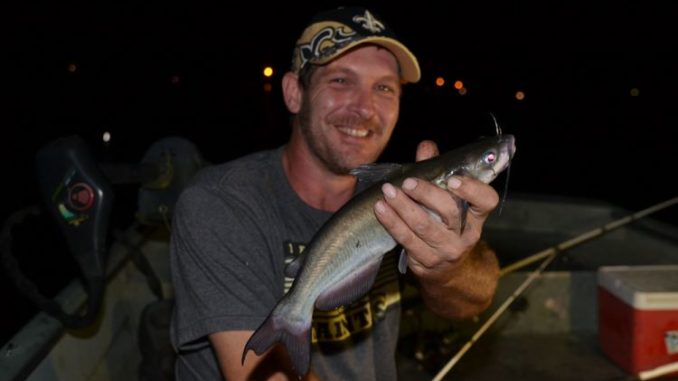
Guillaume reeled his lines in and called Haynes to take his place on the bow. “Here. I catch fish; you harvest them.”
“I can’t deny it,” growled Haynes delightedly. Juglines were definitely his game.
At the end of the run, Guillaume stopped the boat near the middle of a line. “Are we too close,” he queried Haynes.
“Nah,” he chuckled. “Catfish don’t have much brains. They just smell something, swim to it and eat it.”
By 4 a.m., I was so groggy, I was punch drunk, but Haynes was alert and Guillaume was energetic.
Right before daylight, the catching almost became monotonous. Guillaume swung one cat after another over the gunnel.
Finally, I cried uncle.
“I usually don’t quit until I run out of bait,” said Guillaume, a little sheepishly.
They motored me to the landing where my truck was waiting, then turned the boat around, waved and headed back out.
The drive home was hell.
Tip of the day
Christopher Guillaume, a master at catching catfish on rods and reels, uses a most unorthodox way of baiting his hook. After threading the worm the length of the hook, he pushes the entire segment of worm up the line immediately above the hook.
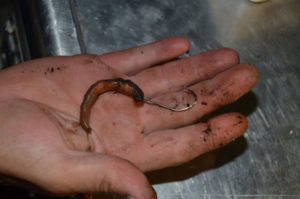
“People give me a hard time about that,” he laughed.
“I don’t,” retorted Haynes. “It works. It’s crazy — but it works.”
The proof was in the pudding. Both men were using the same 2/0 hooks, but rod-for-rod, Guillaume was vastly out-catching Haynes.
In spite of Guillaume racking up the fish without Haynes even getting a bite, the older man kept fishing one rod baited with the worm on the hook the traditional way.
“I just like being out here; it’s relaxing,” was his justification.
Part of the truth, too, is that Haynes is a dedicated jugline man.
The hunter and the lake
Sixty-five year old Sidney Haynes is back at home when he is on False River. Born in New Roads, he left when he was 14 years old. Now living in Denham Springs and retired from plant construction and pipeline work, he still feels the pull of his roots.
“I was on this river as soon as I could walk on a boat. Every time over the years that I came back into town, I came back to the river. Almost always I caught catfish.
“My grandfather Leo Olinde taught me how to fish. He sold catfish and other rough fish. I went to jugs 20 years ago. Before that, I used rods and reels and trotlines.
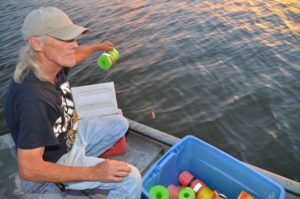
“The average person who used juglines then used plastic bottles — oil, Crisco and two-liter bottles. But there was no place to put the hook and the weight. And they were too big — they took up too much space.”
Haynes owned up to fishing two or three times a week when he’s not deer hunting. He is a serious jug fisherman, fishing Bayou Pigeon, Lake Verret, Lake Palourde, the Amite River and even Toledo Bend, besides his regular runs to False River.
“I go by myself a lot now; and I go with him,” he nodded toward the younger man. Christopher Guillaume, who isn’t retired and still has to work, fishes with Haynes twice a month.
They both eat a lot of fish. “I make a lot of catfish burgers,” said Haynes. “I bake the fish in an oven with salt, pepper and onion. Then I flake them, mix the meat with instant potato flakes and milk, and make patties.
“I brown them in a skillet with a little butter, then put them on a hamburger bun with lettuce, tomato and a cheese slice. Mmm!”